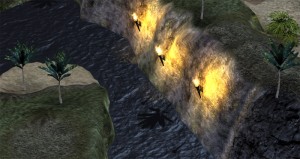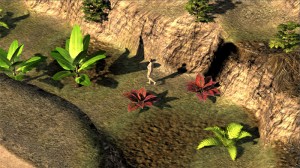What do I want my game to look like? These qualities come to mind:
- different, web varied
- moody
- natural
- scary
Let’s talk about natural first. I’ve always wanted to design a game where natured played a prominent roll. This could come in many forms: harvesting plants for magical properties, rain affecting combat, plot related to environmental damage, climate change, dramatic weather enhancing mood, dangers posed by flooding or earthquakes. Visually speaking, the mood-enhancing abilities of a natural environment seem interesting to explore.
I’m fairly certain I want to go ahead with a dynamic weather system that includes day/night cycles, rain, snowfall, snowpack, wind, fog. Other than the obvious difficulties of implementing any special effects, there are additional challenges that come with this. It means having an unpredictable environment for gameplay. I as a designer no longer have strict control over the look of a region at a particular time and place. This would probably drive a lot of artists mad, but I am not an artist – or at least I don’t have the skills or resources to force a particular time and place to look at certain way.
But I do have the ability to set up the environment so that it can manifest what I’ll call “emergent beauty”. As an example, I’ll put forth the weather demo video I have on youtube. I’m sure I’ll have more impressive video demos as time goes by, but I was pleased with how this turned out – how unexpected it was, mostly. I’d been working on a bunch of systems in isolation: precipitation, wind effects on vegetation, a wind speed algorithm based on weather systems moving across the world, a wind gusting implementation, making different varieties of plant models. One evening I decided to see how it would all come together. I spent 10 or 15 minutes in my world editor painting some terrain textures and placing a random variety of plants over a small piece of the world. Then I activated the placeholder character model, moved it to that location and waited for a windy rain storm to move in (I have a key that speeds up weather systems, so it is a quick wait).
My face lit up with excitement as I experienced the environment for the first time and imagined myself navigating a valley in the jungle at night in a wind storm, off to explorer some secret place. Suddenly the world had come alive.
The loss of control resulted in a memorable moment for me, but it could also result in unexpectedly stupid moments if I’m not careful. What if it snows in the tropics? (I have a climate modifier for the weather, so hopefully I can prevent this from happening). What if I have gameplay or tasks that require a particular form of weather? (Again, climate modifiers could enforce this). What if a particular type of weather looks really bad in a particular environment? What if it’s pouring rain and NPCs are outside talking as if they’re oblivious? Does this mean all NPCs need to be aware of the weather? Could this result in an explosion of work for me?
These are all things I need to consider when committing to dynamic weather. Hopefully with enough foresight I can avoid most of the pitfalls. As it stands now the main reason behind dynamic weather is for the natural varied “emergent beauty” it can provide (if done well), and the sense of wonder and immersion it may impart to the player. I do also have ideas for puzzles that relate to the weather, but these are not the prime motivator.
With regards to being moody, lighting plays a big roll. It is challenging to balance the lighting between: sunlight/moonlight, ambient light, emitted light like torches or “magical” glows. I have implemented an HDR (high dynamic range) system which makes this a little easier to control. For instance, a campfire will emit the same amount of light whether or not it is during the day or at night. But it will appear much brighter at night due to the dimmer ambient light (I even have ideas for puzzles that depend on this).
The nicest light is during the “golden hours” near sunrise or sunset. Unfortunately those only last a few minutes at a time. For much of the rest of the time your are lit with boring midday sun or moonlight. I don’t have any plans to add “artificial” dramatic outdoor lighting just yet, but that may come later if I deem it necessary. Of course, this adds a development/design burden. Again, I save more development time if I am able to make automatic lighting beautiful and moody enough.
Note that I said I have no plans to add artificial dramatic outdoor lighting. But I fully expect that I may want to place explicit light sources in dark areas (inside, or underground in caves, etc…). This may bring me to scary. This isn’t going to be a horror game by any means, but I would like to have spooky moments. Shadows of monsters out of sight around the corner briefly projected against a wall. Mysterious people dramatically backlit and visible only by their silhouettes. Bright flashes briefly illuminating some figure or mysterious scrawl on a rock. I want to use lighting to add mystery.
Picking places to shine. In order to have my game stand out, I’d like to pick a few places to shine (especially since there will be so many places where limited resources mean I won’t be able to live up to modern professional quality graphics). The vegetation wind animation is one place I already think I stand out. I’m not sure where else yet. If I could light my particle systems like this, then that would be another place. If I could have stone paths that don’t blend smoothly into grass that would be another place (only slightly kidding here – you would be amazed at how many AAA games do this. It looks so unrealistic, but we are used to it).

